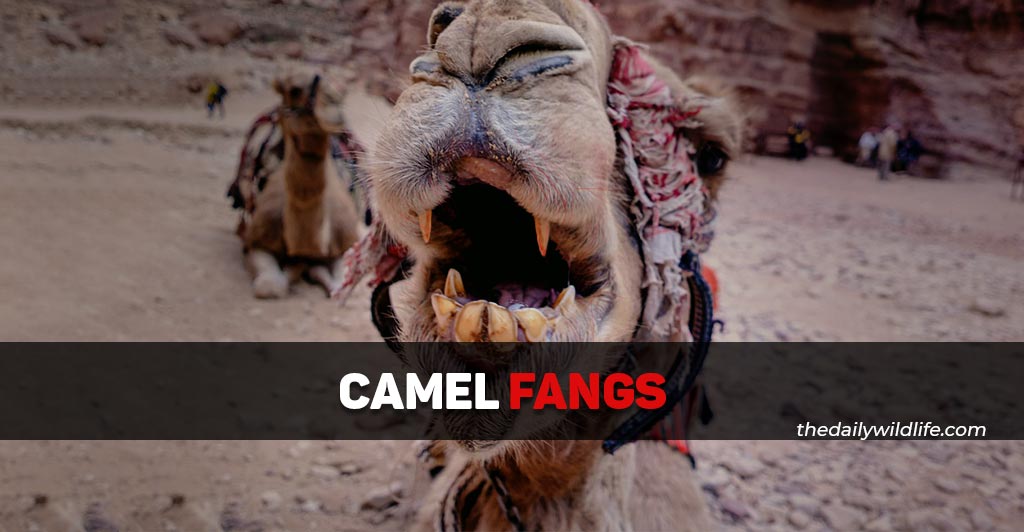Camels do have fangs. Their fangs (upper canine teeth) are long pointed teeth used for holding the food firmly and tearing it apart, and occasionally as weapons. They are conical in shape and can grow up to 1.5 inches long (4 cm).
Before moving any further, it’s important to explain the difference between canine teeth and fangs.
Both the canines and the fangs are sharp-pointed teeth. When talked about in the context of the upper jaw, fangs can be considered the same as canine teeth.
The difference is that fangs are mostly used by carnivores and omnivores to hold and swiftly kill prey.
Camels are herbivores, and sometimes they will consume meat.
When they can not find enough food, a camel will resort to eating meat, bones, animal skin, and even fish.
It is important to note that camels do not hunt and kill other animals with their fangs, they will only eat meat when they encounter a cadaver and there is no other food available.
In this article, fangs will be referred to as canine (dog) teeth of the upper jaw.

Table of Contents
Key Points
- Camels have fangs for grasping and tearing food and self-defense.
- They may consume meat when other food is scarce.
- Camels develop milk and permanent fangs in their lifetime.
- These fangs are used for crushing tough vegetation and during mating season battles.
- Camel bites can cause severe injuries to humans due to their sharp fangs.
How Many Fangs Do Camels Have?
A camel has 22 milk and 34 permanent teeth. When talking in the context of the upper jaw, in its lifetime, a camel will have 2 milk fangs, and later replace them with 2 permanent fangs.
A camel is born with no teeth.
At the age of three months, it will start to develop two milk fangs (canine teeth) in the upper and two milk canine teeth in the lower jaw.
At the age of 4, all of their milk teeth will begin to be replaced by permanent teeth.
At around 6 years, fangs will start to appear; by the age of 7, their fangs and canine teeth will have fully erupted.
Around the age of 12, fangs of the upper and canines of the lower jaw will start to wear off.
Age, breed, genetics, but also the type of food a camel was mostly consuming can have an effect.
Chewing hard leaves, thorns, and shrubs can impact that deterioration.
If They Don’t Hunt, Why Do Camels Have Fangs?
Camels have fangs to help them crush branches, thorny, and other woody vegetation. They also use fangs during rutting season, when they are fighting with other males to assert dominance and win the chance to mate with females.
A camel will mostly feed on grass, grains, leaves, seeds, and similar plants.
However, that’s not what it prefers to eat.
According to Kenyan camel herders, when given a choice between browsing and grazing, a camel will almost always choose to eat branches and twigs and thorny browse.
Their tough teeth and fangs allow them to break through the hard bark and woody tissue of these plants.
Another reason to have fangs is to help them fight with other males and win.
When camels are in a rut, you do not want to get in their way.
They become extremely aggressive, dangerous to handle, and are guaranteed to pick fights among themselves.
They will throw their pink sac (dulla) out of their mouth, start foaming, spit, and start biting one another.
They will mostly try to bite each other’s ankles which can cause inflammation of the joint, and later arthritis.
This is why some camel owners will cut their fangs, to at least put them somewhat under control and prevent such injuries.
Camels are also known to hurt humans, not only other members of their herd.
A study in the United Arab Emirates discovered that out of 33 patients admitted to hospital for camel injuries, 80% of them were bitten. There was even one death recorded due to such injuries. [1]
Their razor-sharp fangs can cause small surface injury, but extensive soft tissue, blood vessel, and nerve injuries.
In the USA, camel injuries are not that often.
It is estimated that there are around 3000 camels in total there, but most of the bites will only happen in a few select locations, such as zoos and exotic animal farms.
What makes the situation even worse is that after those bites, wounds might get infected.
Infection rates from camel bites have been reported to go as high as 86%. [2]
Examination of the camel teeth and camel skull that allows us to get a better glimpse of the animal’s whole dental structure is called dental radiography (dental X-ray).
Because of their sharp teeth, self-inflicted injuries to dullas are also found in camels. The animal cannot blow out its dulla and can’t eat food properly.
Final Thoughts
This concludes our article on camel fangs and the danger they possess.
Camel fangs are sharp and long upper-jaw canine teeth that camels use to break hard woody plants and to fight off other males during mating season. Camels with fangs can be dangerous animals for humans, as camel bites can cause serious health injuries.
Want to learn more about camel teeth? Read our article about camel teeth facts by clicking here.
References
[1] Abu-Zidan, Fikri M., et al. “Camel bite injuries in the United Arab Emirates: a 6-year prospective study.” Injury 43.9 (2012): 1617-1620.
[2] Calleo, Vincent J., Patrick O. Curtin, and Amy S. Biondich. “Camel bites: a case study with a summary of current epidemiology, injury patterns, and treatment modalities.” Wilderness & environmental medicine 29.3 (2018): 380-382.